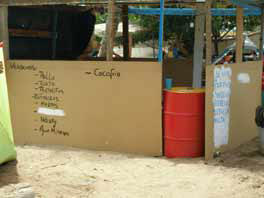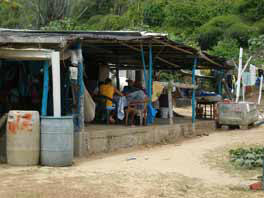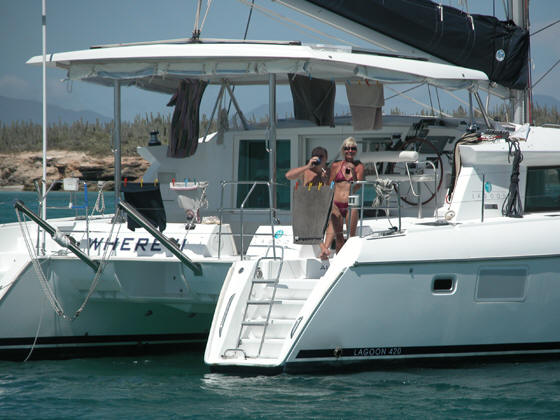
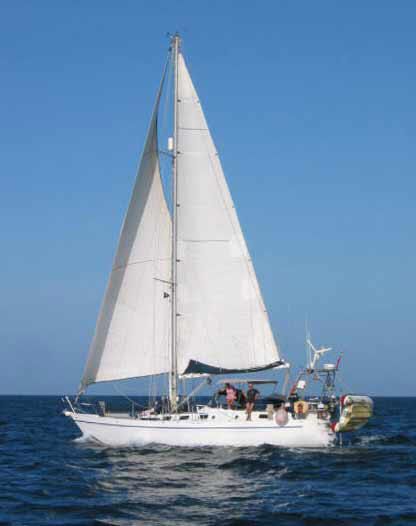 |
So finally all our generator bits have arrived and we're as ready as we'll ever be to leave Grenada for Venezuela. It is now much later in the year than we'd planned, the hurricane season has already started and we've watched many of the boats we'd planned to buddy up with leaving already. Few yachts chose to make this trip alone. It's only about 200 miles down to Puerto La Cruz, with a handful of island stops on the way and (hurricanes not withstanding) near perfect sailing conditions, but the Venezuelan coast has an evil reputation for piracy and violent crime. As always the rumour machine amplifies the perception of risk, but there's no getting away from the fact that a small number of yachtsmen have been killed in the last couple of years. We'll be keeping as far away as possible from the known danger areas, but even so some company would be nice. As it turns out Matt & Karen on the Australian cat "Where II", who we'd talked to about sailing together a while ago, had been happy to use the delay to do more shopping and then, a few days before we were ready to leave the British Super Marimu "Jackster" (David & Jackie) also joined the group. So in the early evening of September 15th our mini armada set sail for Los Testigos. Our aim was to keep in visual contact throughout the 100 mile trip. Taking account of the different size and design of boats the plan was to keep pace with the slowest boat, which should be us. To that end, we would leave first, followed by the larger Jackster and finally Where II, who as a cat should be way fastest of the group. Well so much for planning. Just before we were ready to leave a Swiss boat dropped his anchor over the top of ours and promptly disappeared to the bar. Sorting that out took a while, so we were last out of the bay and as we cleared True Blue point, Jackster was off in the distance and Where II were marking time, waiting for us to sort ourselves out. None of this really mattered because it turned out that our estimates of relative boat speeds where wildly out. It didn't actually take us long to catch up and overhaul Jackster (a bit of a surprise to us) at which point we wound in some genoa to keep pace with them. The big surprise was that we were both pulling away from Where II. How could a cat be that slow? Just how much beer could they be carrying?? |
| We never did find the answer, but at
around 8pm we called Jackster to let them know we were shortening sail
still further so as not to lose sight of Where II and they did the same. At 0900 the following morning we all dropped anchor within a few minutes of each other, behind Isla Grande, Los Testigos and hoisted our Venezuelan courtesy and Q flags. |
|
| Los Testigos is a protected area and normally home to
a few fishing families and a small coast guard station. It's not a
port of entry, but normally, as in our case, the Guardia will allow you
to stay for a few days. We had arrived during the week long
festival of the Virgen del Valle, several boat loads of tourists had
travelled the forty or so miles from the mainland to take part in the
festivities. This meant that the population of the island was
roughly quadrupled, the beaches were lined with tents and the few shacks
and houses were decked with flags and decorations.
After an extremely wet dingy ride across to Isla Iguana (where the fishermen live) and checking in with the Guardia, we all wandered along the one short "street". I think we all quite fancied the idea of a slow beer in a local bar to watch the world go by for an hour or so, but by some process of unspoken unanimous agreement, we found nowhere we wanted to stop. It has to be said that even during its biggest week of the year, Los Testigos is not much of a place. |
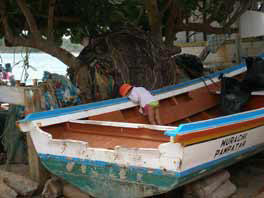 |
|
|
We stayed another 24 hours on Los Testigos. We were visited by a boat load of local fishermen who were rebuilding an outboard motor and were short of a spanner for the big end bolts. They lifted the motor onto our deck to show us the size of the nut. We had a spare of the right size so gave it to them. Now sailing stories abound of the generosity of the fishermen, who virtually sink sailing boats under the weight of free seafood, etc in exchange for a glass of rum or some small kindness. So what did we get in return for our spanner? A lobster? Some prawns? A fish finger?? None of the above. What we got was an oil stain on our deck! |
|
| Next stop was Porlamar on Margarita. Margarita is a much bigger island, about 35 miles long, and a big holiday destination for wealthy Venezuelans. One of the major attractions being that it's a duty free port and it's a common site in the supermarkets to see trolleys tottering under an impossibly high mountain of whisky bottles - A surprisingly fact is that Venezuelans consume more whisky per head than any other nation on earth. | |
| The bay at Porlamar is large, sandy, well protected and at first
glance surrounded by luxury hotels and marinas. At second glance many of
the hotels are incomplete, the infrastructure is missing and the marinas are in
fact a few rickety piers. This is Venezuela! Porlomar is another of those places where yachties have become stuck. In this case the main nationality of the "stuck" are Brits. Life here revolves very much around a pre-sunset beer, or several, sitting on a plastic chair in the dusty car park of Juan's dinghy dock and mini market. Or maybe every other week or so a barbeque - same venue. Now Juan is an "interesting" paradox - a slightly built, middle-aged Venezuelan with a moustache that in most countries would require planning permission and quite likely harbours several species - as yet unknown to science. He has a slightly haughty attitude and we never came across anyone who had anything good to say about him, but everyone uses his dock. |
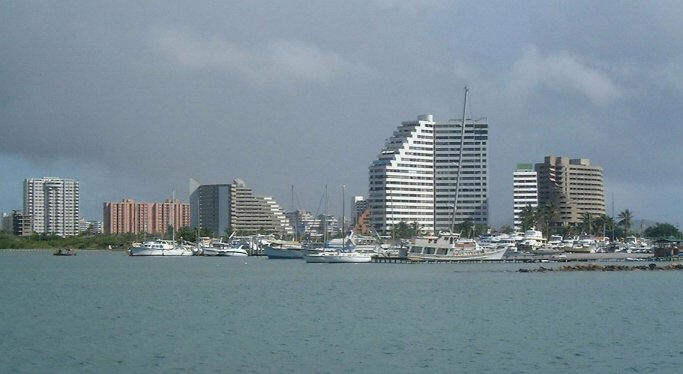 |
|
So let's examine all the things his setup has got going for it: His dingy dock is well away from all the bars, restaurants, etc in an extremely shallow corner of the bay so that you risk losing your propeller every time you visit it and because of it's remoteness you certainly wouldn't want to leave your dinghy there after dark. His dusty mini market only contains the few over-priced items that most beachside mini markets contain, which is to say you'd have to be desperate to buy anything there. You can't even get a taxi there since he started trying to charge the taxi drivers for using his car park. A few hundred yards along the beach is a small marina with a free dinghy dock and twenty four hour security. It's close to the bars, restaurants, hotels and the most popular beaches in the area. Because of all of this there are also always plenty of taxis. Additionally, it's just a short walk from the new port captains office which houses all the immigration services a visiting yacht needs. Now Juan's raison d'etre has always been handling the clearing-in process on behalf of visiting yachts, which prior to the building of the new port captains office required multiple trips to various offices, but now is a piece of cake. He still offers his service and charges Bsf350 to clear you in. Alternatively, you can take your dinghy to the nicer, cleaner, safer, etc dock up the beach and do it yourself for Bsf 150 and spend what you've saved having lunch in one of the restaurants by the beach. In spite of all of the above 90%+ of cruisers tie up at Juan's dock and pay Juan to clear them in. If anyone can explain it - answers on a post card to........... |
|
|
And finally to put to bed what is becoming a bit of a rant and to avoid charges of being disingenuous:- Are there any additional complications with doing your own clearance? One thing - you will have to take the slip of paper they give you into the bank in the centre of town, pay the fee, and return to the captains office with the receipt to complete the process. That's a Bsf15 taxi ride (c. US$3.00 at the time of writing) each way. But the bank is slap in the middle of the main shopping area where you'll almost certainly want to go to hit the shops and to change up some money in one of the gentlemen's clothing stores. (If you don't understand the last bit, just ask another yacht in the anchorage!) Surely Juan offers some other valuable services that you've failed to mention? Your sort of right. Every Monday there's a "free" shopping bus from Juan's car park to the Sigo supermarket and back. This is a really handy service, particularly if you're doing a big shop, as the shopping comes back in a separate truck. A couple of points though: The bus is provided by Sigo not by Juan and there's no compulsion to have used Juan's clearing service in order to use it. It's also not quite "free" - there's an obligatory Bsf10 tip for the boys. You could also do this trip an awful lot of times in a taxi with what you saved by clearing in yourself! |
|
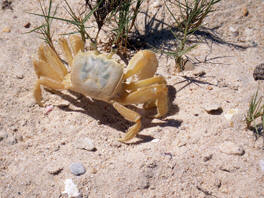 |
So what else is there to say about Margarita. Well, Margarita is mainly about shopping. Booze and cigarettes are cheap. There's also a greater availability of stuff, particularly at the luxury end of the spectrum, than exists elsewhere in Venezuela. The same is true of anything for yachts. Though, if you thought the chandlers in the Caribbean where expensive........ Bring absolutely everything yacht related that you think you might need! Fuel is cheap as it is everywhere in Venezuela, though in Margarita, as in many places foreigners have to pay the special gringo price, (roughly ten times the locals price) but even so that's only the equivalent of US $0.20 per litre. In Cumaná though you can buy it at the same price as the locals!! We took ours at the gringo price from a fishing boat that pumped it out of a container on deck into our tanks. We knew we were being ripped off by 1000%, but it was still the cheapest fuel we'd ever bought. Also Miguel who owned the boat, turned out to offer the best exchange rate for Bolivars, that we'd yet found so, swings and roundabouts. We stayed in Margarita for about three weeks, stocking up with beer, wine, serrano ham and sarongs - I don't know why, but Traki a kind of local department store, seemed to have cornered the global market in cheap sarongs!. We also waited for Inspiration Lady, who were carrying a new wind generator for Jackster, to join us from Trinidad. |
|
There was another reason for waiting. Word had just come through that the authorities in Puerto La Cruz had introduced a new tax to be levied on all foreign flagged boats at 1% of the boat's value! Crazy money! We were in contact with Tim & Pauline on Nanou, who also have an apartment in PLC. Yes it was true. It was a move by the authorities to bring to heel wealthy Venezuelans who were avoiding taxes by using flags of convenience. It wasn't aimed at foreign cruisers, they'd just got caught in the net. Everyone was working to fix the situation - not least the marina and boat yard owners who saw their businesses going down the drain as the foreigners departed. Tim was sure it would sort itself out, it just needed a bit of time. We weren't sure how much time and whether a solution would be soon enough for us and we were not alone. Much studying of charts and pilots. Emails to boat yards in other countries and questions to our insurance company - Will you extend cover to Columbia? Our cruising plans would be in tatters. Of course you'll have spotted that the title of this page is Venezuela. So it did sort itself out and we did go to PLC, but that's getting ahead of ourselves. As we were preparing to leave, Margarita played host to a conference of South American and African Heads of States. The island virtually closed down. War ships and helicopters patrolled the gulf. Anchored yachts were visited by the coast guard and told to get their flags in order. Streets were cleaned, lamp posts painted and red-shirted groups of Chavistas were strategically located at every corner. The conference was held at the Margarita Hilton, quite a coup for its management team you'd think. Well maybe not. One way or another they obviously made an impression on El Presidente, because the following week the Margarita Hilton was nationalised! |
|
| Where II and ourselves hauled anchor and
headed for the island of Cubagua. Jackster and Inspiration Lady
would hit the shops one more time and join us the following day.
This 20 mile trip is in the lee of Isla Margarita so the sea is
completely flat, but the wind and current are both accelerated by being
squeezed around the bottom of the island. This combination
guarantees an exhilarating sail in near ideal conditions. It also
guarantees that the anchorage behind Cubagua, the land being only a few
metres above sea level, whilst safe and flat is also extremely windy. Cubagua, was actually the site of the first European settlement in what is now Venezuela. The flat terrain offered extensive salt pans, but much more important were the oyster beds on the other side of the island. At one point we read, the Spanish crown was receiving more revenue from Cubaguan pearls than from South American gold. The beds are long since exhausted of course and now protected, but the remains of the original town are still there. Cubagua's problem, then as now, was a complete absence of fresh water. The Spanish established a second settlement on the mainland from where water could be shipped back to the island. Today the government has built a small desalinisation plant to supply the handful of fishing families and the coast guard station. |
|
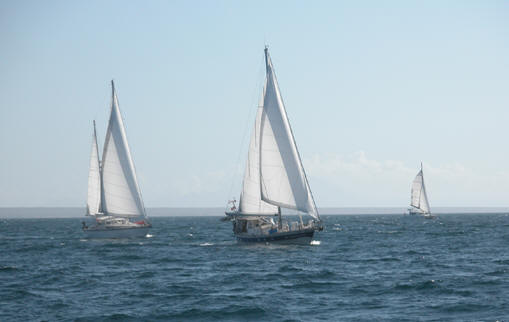 |
That about sums up Cubagua. We stayed a couple of nights and then headed for Puerto La Cruz. This was to be a parting of the ways. The other three boats would turn south east at the Punta De Araya, to Cumana (Diesel @ $0.02 per litre!) and into the Golfo De Cariaco. (Scarlet ibis and magnificent scenery.) We would continue south west to Puerto La Cruz. (Marina, boat yards, painting, repairs.) Unfortunately this meant that we would sail the last thirty miles, threading between the mainland and the off lying islands alone and we knew for a fact that within the last year one yachtsman had been killed and another wounded in a shooting on one of these islands. Seeing the other boats' sails disappearing into the distance was thus even more poignant than usual. However, we're clearly not very good at building up tension because we already mentioned further up the page that we did go to PLC and also I'm clearly typing this web page. With the exception of some stunning rock formations there is absolutely nothing of note to report from that last 30 miles. And then we were there, flexing our Spanish on the VHF arranging for some assistance getting into the slip, and finally, tied up in a marina for the first time in a very long time and only a few boats away from Nanou.
|
